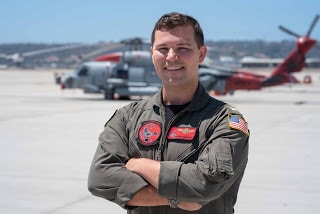Story written by Senior Chief Mass Communication Specialist William Lovelady, Navy Office of Community Outreach
Lt. j.g. Derrick Marchant, a native of Jackson, Mississippi, started talking to a Navy recruiter and considering options before he graduated from college.

Now, almost four years later, Marchant serves with the Scorpions of Helicopter Maritime Squadron (HSM) 49, working with one of the Navy’s most advanced helicopters at Naval Air Station North Island, San Diego.
Marchant, a 2009 graduate of Jackson Academy, is serving with a versatile squadron that’s capable of completing a number of important missions for the Navy with the MH-60R “Seahawk” helicopter.
As a new member of the squadron, Marchant has a lot of ground to cover.
“In addition to flying the helicopter, I write pilot schedules and run meetings,” said Marchant.
Marchant credits success in the Navy to many of the lessons learned in Jackson.
“I got a lot of morals and life lessons from my parents and grandparents,” he said. “How you treat people is very important.”
As the U.S. Navy’s next-generation submarine hunter and anti-surface warfare helicopter, the MH-60R “Romeo” is the cornerstone of the Navy’s Helicopter Concept of Operations. Anti-submarine warfare and surface warfare are the MH-60R’s primary missions. Secondary missions include search and rescue, medical evacuation, vertical replenishment, naval surface fire support, communications relay, command, control, communications, command and control warfare and non-combat operations.
“It’s a lot of fun to fly,” said Marchant. “I’ve flown a lot of different types of missions. Lately, I’ve been focusing on day and night search and rescue missions. Next month we’ll be focusing on tactical training.”
“Our priorities center on people, capabilities and processes, and will be achieved by our focus on speed, value, results and partnerships,” said Secretary of the Navy Richard V. Spencer. “Readiness, lethality and modernization are the requirements driving these priorities.”
Though there are many ways for sailors to earn distinction in their command, community, and career, Marchant is most proud of proving to himself that it’s possible to become a Navy pilot and get his Wings of Gold.
“I’m usually my own worst critic, but I’m learning to trust the process and know that if I give my all, the Navy has set me up for success,” said Marchant.
As a member of one of the U.S. Navy’s most relied upon assets, Marchant and other sailors know they are part of a legacy that will last beyond their lifetimes contributing to the Navy the nation needs.
“Serving in the Navy means working together,” said Marchant. “The people are the best part. Working toward a common goal is very satisfying.”







